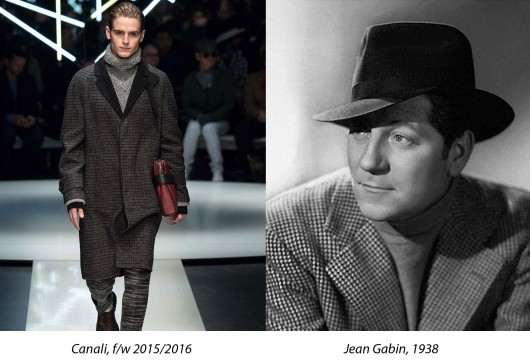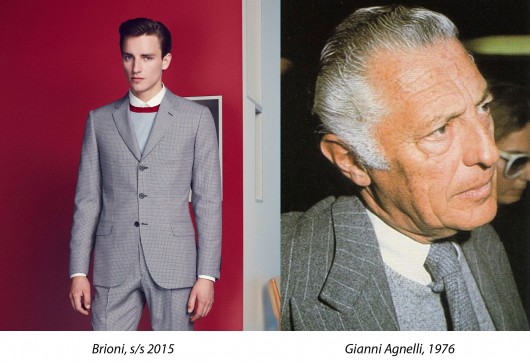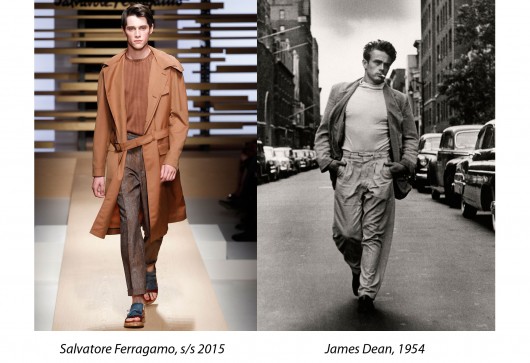ECLECTIC WARDROBE
Come sempre le Signore si “svegliano” prima. Anche nel riconsiderare, con spirito di iniziativa, le possibilità di abbinamento dei vari pezzi di un normale guardaroba. Per esempio, hanno introdotto i pantaloni nell’abbigliamento da città, prima confinati alla vacanza e/o alla pratica sportiva. Lo hanno dovuto fare durante la guerra, visto che si sono trovate a svolgere attività maschili o presunte tali. Si sono poi fatte una ragione, senza soffrirne troppo, il “rappel all’ordre” giunto con il new look di Monsieur Dior.
Ma al primo cenno di allentamento degli imperativi categorici in fatto di moda sono ritornate in massa ai pantaloni: per comodità, emancipazione, desiderio di libertà. Con più cautela, alla reinterpretazione anti-diktat del guardaroba sono arrivati anche gli uomini. Scoprendo che ciò che appariva scontato non lo era affatto. Qui non stiamo parlando né di stravolgimenti, né di introduzione di capi d’abbigliamento futuribili che hanno reso obsoleto ciò che già esisteva.
Semmai, si è capito che di obsoleto c’era solo l’osservanza acritica di norme, che sembravano indiscutibili, riguardanti combinazioni ed usi. Questa strada, ora democratica e percorsa un po’ da tutti, è stata aperta dai soliti modelli di riferimento di stile al maschile. Chi ha mai detto, tanto per cominciare, che il soprabito ben tagliato potesse essere portato soltanto sopra il completo di pari fattura? Qualche “coraggioso” ha iniziato a metterlo anche sopra una semplice maglia.
E lo stesso principio si è affermato per la giacca, magari sopra ad un pantalone un po’ morbido. E a proposito di giacca: ha ancora senso considerarla unicamente come parte di un completo o di uno spezzato da indossare con camicia e cravatta? Proprio no: già da decenni dimostra di andare benissimo anche sopra una T-shirt, tant’è che un grandissimo della moda di oggi ne ha fatto quasi una sua divisa, senza per questo voler buttare alle ortiche né cravatta né camicia. Semplicemente, non sono più qualcosa da subire ad ogni costo.
Va detto, quando ci vogliono ci vogliono: ad una prima d’opera, per esempio, la T-shirt sotto lo smoking o la “tenue de ville” continua a risultare un tantino stonata. Ma anche senza dimenticare che in qualche caso la giacca, già negli anni Cinquanta, in fase pre-Saint Laurent, ha cominciato ad avvicinarsi ad una sorta di camicia-sahariana acquistando scioltezza ed una vestibilità più agevole, senza nulla perdere in termini di appeal.
Per concludere con il pianeta giacca: il blazer ha lasciato da un bel po’ gli yacht e ha perso bottoni dorati, alamari e galloni. Ora lo si vede normalmente per le strade abbinato al jeans, talora conservando il blu navy originario, talora in variazioni cromatiche più osate. In parallelo, hanno conquistato terreno pelle e maglieria. Sostituendo proprio la giacca, il blouson di pelle si accompagna da tempo a camicia e cravatta anche nei business look.
E sempre sotto la giacca, è più che normale vedere, e non da ieri, polo o dolcevita. In questo processo ci sono due momenti-chiave. In una prima tappa la maglia si è liberata dalla connotazione “proletaria”: a lungo, per necessità più che per virtù, la camicia buona veniva riservata dai più ai giorni di festa. Successivamente, la ventata esistenzialista/sessantottina ha conferito l’imprimatur decisivo a questo abbinamento.
La comodità, unita forse ad un intento di eccentricità, ha fatto sì che le calzature leisure – vogliamo parlare specificamente di mocassini da barca? – apparissero sotto i completi formali. Prima, già negli anni Cinquanta ad opera dei più ardimentosi apri-pista, poi in misura del tutto generalizzata. E in conclusione, ponendo l’accento proprio sull’eccentricità, che dire del papillon portato anche con le giacche da giorno? O della cravatta ben in vista sopra il pullover? Ma forse è meglio lasciare queste chicche ai dandy che padroneggiano alla perfezione il loro rapporto con ciò che indossano. Giorgio Re
As always, ladies awake to facts before. Also to reconsider, with a great deal of initiative, matching possibilities of everyday clothes. For example, they reintroduced trousers, worn only on holidays and/or in sport practice, in urbanwear. They had to do this during the war, considering they had to replace men in many activities. Then they came to terms, without suffering, with the “rappel all’ordre” represented by Dior’s new look. But at the first sign of loosening of the strict style rules, they came back to trousers: for comfort, emancipation, desire of freedom. With more caution, this reinterpretation of fashion rules has been also made by men. Finding out that what seemed to be expected actually wasn’t. We’re talking not about twistings, nor about the introduction of futuristic clothes that made the existing ones outdated. If anything, the “outdated” thing was the uncritical observance to rules about matches and uses. This path, now democratic and followed by many, has been trod at first by the usual reference models of men’s style. Who said, for example, that the tailored coat has to be worn only over a suit? Some “brave” has started to wear it over a simple sweater. And the same principle is also valid for the jacket, worn in case with a little loose trousers. And talking about the jacket: it hasn’t to be considered only as part of a suit to be worn with shirt and tie anymore. For decades it has demonstrated to fit perfectly even over a T-shirt, so much so that one of the greatest of today’s fashion has choosen this as his “uniform”. It must be said that there are different occasions: at an opening night, for example, the T-shirt under a tuxedo or a “tenue de ville” still turns out to be clashing. But remember that the jacket itself, in the Fifties, in the pre-Saint Laurent period, has started to be more comfortable and adaptable, looking like a sort of shirt-bush jacket, without loosing anything in terms of appeal. Finally, the blazer has left golden buttons, frogs and trims, and now is generally worn with jeans, sometimes in its original navy blue shade, sometimes in more daring colours. At the same time, knitwear and leather started to spread. As a replacement of the jacket, the leather blouson is often worn with shirt and tie even in business looks. And under the jacket, is quite normal to see polo shirts or turtlenecks. In this process there are two decisive moments. On a first step the knitwear lost its “proletarian” feature: for a long time, from necessity, the shirt was set aside for feast days. Then, the existentialist gust gave this match the decisive imprimatur. Comfort, maybe with a touch of eccentricity, has matched leisure shoes – specifically boat loafers – with formal suits. And finally, talking exactly about eccentricity, what about the bow-tie worn with day jackets? Or the tie over the pullover? But maybe those pearls has to be left to dandies that perfectly master their relationship with the clothes they wear. Giorgio Re













